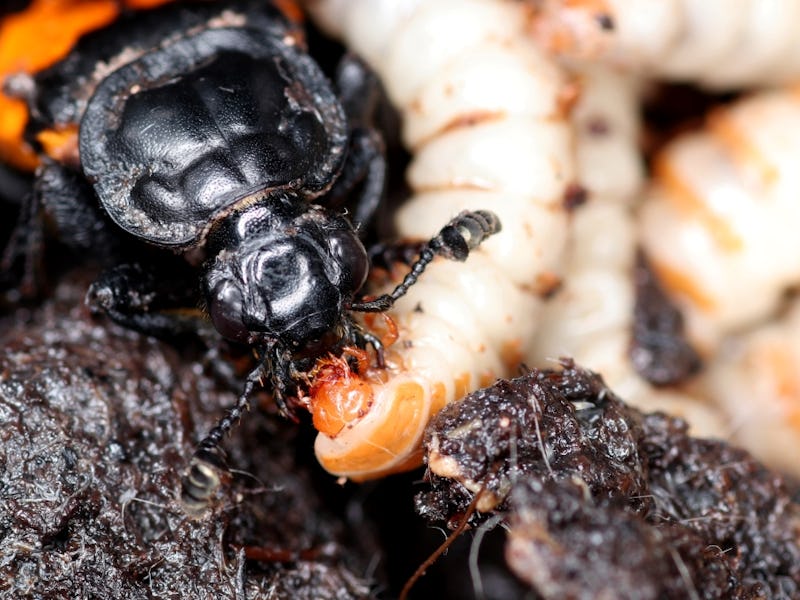Dead body-eating beetle has a bizarre parenting strategy
This creature is disgusting, but only because it's a good parent.

Parents will go to great lengths to make their children happy.
For burying beetles, that means finding the ripest dead body they can get their mandibles on.
Burying beetles, Nicrophorus vespilloides, are named for the bizarre way they set up their reproductive efforts:
Step 1: Find a dead animal, usually a bird or rodent.
Step 2: Fight off others (males or females) to win the prized carcass.
Step 3: Together with your mate, dig a hole below the carcass, remove the fur or feathers, cover the body in anti-fungal oral and anal secretions to delay its decay.
Step 4: Bury it.
The whole burial process takes about eight hours, but it's worth it: The body of the dead animal provides food and a nest for the happy couple's offspring-to-be.
A burying beetle with its young.
And in a study published this week in the journal Animal Behaviour, researchers intimately describe exactly what it means for the beetle to give its offspring the best start in life.
Turns out that older female burying beetles are more particular when it comes to how they spend their child-rearing energy. While younger females are flexible, basing the energy they put into raising their young on the number of offspring and food available, older beetles give parenting their all — unconditionally.
Flexible parenting
From a reproductive perspective, it makes sense for the younger beetles to allocate their energy based on how much food is available — producing more offspring when you have a bigger carcass to play with, for example. That helps the beetles adapt to their environment.
"However, such flexibility takes effort and energy," said Nick Royle, lead study author and a behavioral ecologist at the University of Exeter, in a statement.
"So, for older beetles that may not get the chance to breed again, the best strategy might be to invest everything you have, regardless of the situation."
That means doting on your young to an extent many parents can only aspire to.
While the offspring of burying beetles are able to feed themselves, parents can also eat, liquify, and regurgitate food for them, helping them grow up big and strong.
A burying beetle with a large brood.
Royle's research team gave beetles varying sized carcasses to see how mothers of different ages responded. Younger moms conserved their energy: When there was less food, or a smaller carcass, they put in less effort to raising their larvae, saving valuable resources for the next batch of offspring.
But older moms didn't change up their parenting style based on the amount of flesh they had to eat.
The findings are the first to show how this change happens with age, helping to explain some of the natural variation of these creatures' unusual habits, the researchers say.
"Parental care is hard work," Royle said, "It makes sense not to expend more energy than is necessary if there is a good chance you will get an opportunity to breed again."
Younger moms have the privilege of time — they can hedge their bets, knowing they will likely have a future opportunity to try again with the whole parenting thing. That flexibility, or plasticity, doesn't make as much sense for older beetles, which do not have the luxury of age on their side.
"For older mothers, the chance of them breeding again is less likely," Royle said. "So it is better to just go for it now as they might not have a future."
Abstract: Phenotypic plasticity is an important mechanism facilitating adaptation to environmental change that often varies among individuals. One reason for this individual variation is that plasticity may depend on state variables, such as size, condition or age, which affect the costs and benefits of plasticity. Recent theoretical work predicts that plasticity will decrease as an organism ages because costs of plasticity mean that flexible phenotypic adjustments by individuals to environmental change will be less beneficial as age-related survival prospects decrease. Here we used Nicrophorus vespilloides burying beetles to test this prediction in the context of parental care. Burying beetles use the carcasses of small vertebrates as resources for breeding and have complex, extended, flexible parental care. Our experiment manipulated female age and (the order of presentation of) carcass size in a repeated-measures design to test the prediction that older beetles are less plastic than younger beetles in parental care. We found evidence in support of our central prediction: young females showed greater mean levels of plasticity than older beetles for all traits (parental care, number of offspring, brood mass) except mean larval mass (i.e. size of offspring), with the response to changes in carcass size dependent on the order of carcass presentation for young females but not for older females. Between-trait correlation analysis revealed age-related trade-offs between the size and number of offspring for older, but not young, mothers. The three age-dependent traits, which were intercorrelated, were also repeatable, indicating potential for coevolutionary responses to selection.